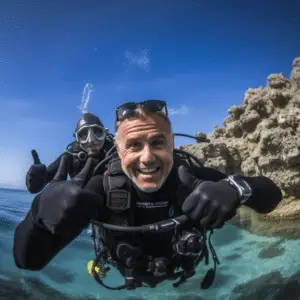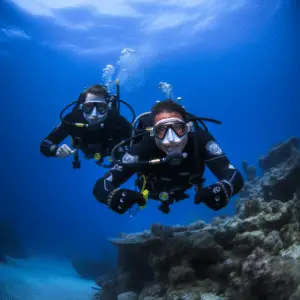
Buddy diving is a fun activity! To make the most of it, we must understand best practices. Communication is key. Before diving, establish signals and underwater hand gestures with your buddy. This helps keep in contact and share vital info during the dive.
Stay close to your dive buddy. This way, you can help if needed. Also, regularly check each other’s gear. This prevents accidents and malfunctions. Have trust in your partner. Discuss emergency procedures beforehand.
Practice buddy diving often. This sharpens your skills and strengthens the bond with your dive partner. So, let’s remember communication, proximity, equipment checks, trust, and regular practice. Don’t miss out on this thrilling adventure! Start planning your next buddy dive today!
Importance of Buddy Diving
Buddy diving is really important in the underwater world. It makes sure you’re safe and makes your dive even more enjoyable. With a buddy, you have an extra set of eyes to spot danger and help if anything goes wrong. Plus, you can communicate with hand signals and stay coordinated. Having a buddy helps build confidence, so you won’t panic or get anxious.
Buddy diving also brings people closer! You get to explore marine life together and make memories that will last. The bond between buddies is special and makes each dive even more exciting.
If you haven’t tried buddy diving yet, don’t miss out! It’s not only safe, but it also lets you make new friends and have amazing experiences. So grab a buddy, get ready, and dive into the magical underwater world!
Choosing a Buddy
Selecting the right dive partner is very important for safety underwater. Consider these points when deciding:
- Are you compatible? Find someone with similar skills and experience. This makes sure you both understand each other’s abilities.
- Good communication? Look for someone who knows dive signals and can share info underwater.
- Can you trust them? Choose someone responsible, reliable, and follows safety rules.
- Is your buddy aware? Choose someone with great situational awareness. They must be responsive and spot risks/hazards while diving.
- Do they know their gear? Pick someone knowledgeable with their equipment. They should know how to use it and troubleshoot issues.
- Are they prepared? A reliable buddy should have a first aid kit, know basic rescue techniques, and be trained in CPR.
Keep these points in mind when selecting a dive buddy. Your buddy is your lifeline underwater – so choose wisely!
Communication Techniques
Divers use hand signals to communicate vital messages, like ‘OK’, ‘Dive Down’, or ‘Ascend’. Using underwater communication devices, divers can also send voice messages. The writing slate is a useful tool for writing quick messages or drawing diagrams.
It’s important to have a pre-dive briefing to discuss the signals to use underwater. This helps avoid confusion.
For example, two buddies were once separated by a strong current off the coast of Australia. With clear communication and teamwork, they used their agreed-upon hand signals to inform each other. They safely reunited with the group.
Pre-Dive Preparation
- Step 1: Equipment Check – Before a buddy dive, inspect all gear. Fill and secure scuba tanks to the BCD. Check the regulator for damage. Test the dive computer. Lastly, inspect masks, fins, and snorkels for faults or leaks.
- Step 2: Dive Planning – Coordinate with your buddy for details like dive depth, bottom time, emergency procedures, and hand signals. Agree on clear communication underwater.
- Step 3: Physical Readiness – Be physically fit for safety. Exercise regularly to boost lung capacity and stamina. Get enough rest before diving for mental sharpness. Have a buddy system with surface and emergency checks.
A 2009 incident in Australia’s Great Barrier Reef highlights pre-dive prep importance. Two experienced divers failed to communicate their planned route. This confusion and panic underwater shows the significance of thorough pre-dive discussions.
Underwater Techniques
Dive deep into the must-have underwater techniques for buddy diving! These methods help with communication, safety, and navigation. Here’s what to know:
| Technique | Description |
|---|---|
| Buddy Checks | Check gear before getting in the water with your buddy. |
| Hand Signals | Use signals for communication underwater, no talking needed. |
| Buoyancy Control | Stay at neutral buoyancy to preserve marine life and make for a better dive. |
| Navigation Techniques | Know how to use a compass, natural hints, and landmarks to navigate. |
Pro Tip: Practice these regularly to feel more confident and work better with your dive partner.
For a great buddy diving experience, remember these techniques and get your gear ready! You and your buddy are about to explore the underwater world!
Emergency Procedures
In the ever-changing underwater world, it’s essential to be ready for anything. Quick thinking and proper procedures can make a huge difference in keeping buddy divers safe. So, let’s get into the basics of emergency procedures every diver should know.
- Communication is key! Set up clear hand signals and dive plans ahead of time for effective communication in an emergency.
- If separated, both divers should look for one another. If unable to spot each other, ascend slowly together while maintaining a safe rate.
- If difficulty breathing or signs of DCS occur, ascend slowly and safely. Safety stops may help reduce risks.
- In an out-of-air situation, stay calm and share air with the alternate air source while ascending gradually.
Also, be familiar with managing entanglement and equipment failure. Stay calm and take the right actions for a safer outcome.
Carry an emergency signaling tool like a whistle or SMB. These can help attract attention and aid in rescue operations if needed.
Remember, being prepared for emergencies improves safety and gives more confidence on each dive journey. Stay alert, stay informed, and happy diving!
Post-Dive Debriefing
Debriefing is more than facts – it’s a chance to grow as a diver. Embrace feedback and actively listen to your buddy’s observations. This creates a supportive environment that fosters learning. Don’t underestimate the power of post-dive debriefing!
Reflect on the dive details, such as depth and time underwater. Also, take note of any noteworthy incidents. Evaluate how you communicated with your buddy underwater. Share any marine life or underwater features you encountered. Lastly, address any issues that arose during the dive.
Post-dive debriefing can ensure continuous growth, promote safety, and strengthen bonds between diving buddies. Start practicing it today to make every dive count!

Conclusion
When buddy diving, communication is key for quick response in case of emergencies. Also, agree on hand signals and establish a primary and secondary diver role. Practicing proper buoyancy control helps conserve energy and prevent accidental contact with marine life. Periodically check each other’s gear to ensure safety. And Pro Tip: always debrief after a dive, discussing the dive highlights. By following these best practices, divers can enjoy a safe and amazing underwater experience! So grab your buddy, gear up and dive in!
Frequently Asked Questions
Q: What is buddy diving?
A: Buddy diving is a recreational scuba diving practice where two divers closely monitor and support each other throughout the dive. They are responsible for each other’s safety and can assist in case of emergencies.
Q: Why is buddy diving important?
A: Buddy diving enhances safety underwater as the divers can rely on each other for assistance. It helps to prevent accidents, provides a backup in case of equipment failure or emergencies, and allows for shared experiences during the dive.
Q: What are some best practices for buddy diving?
A: Firstly, proper communication and dive planning are crucial. Clear signals, understanding hand signs, and discussing the dive plan beforehand ensure a smooth dive. Secondly, maintaining close proximity to each other underwater and frequently checking on each other’s air supply and well-being is essential. Thirdly, continuous communication and regular hand signals help to convey any problems or changes in the dive plan underwater.
Q: How should divers prepare for buddy diving?
A: Divers should ensure they have the necessary certifications and training to dive safely. They should familiarize themselves with their buddy’s gear and establish clear communication methods. Discussing emergency procedures, agreeing on dive signals, and conducting pre-dive equipment checks are also important preparation steps before buddy diving.
Q: What should I do if I lose sight of my buddy underwater?
A: If you lose sight of your buddy during a dive, follow predetermined procedures. Ascend slowly to a shallower depth while scanning the area for your buddy. If you cannot find them within a designated time, perform a controlled ascent and meet at a prearranged location on the surface. Always ensure your own safety during this process.
Q: Can I buddy dive with any certified scuba diver?
A: Ideally, buddy diving should be done with someone who has similar experience, skills, and comfort level underwater. While diving with any certified scuba diver is possible, it is recommended to buddy up with someone whose capabilities align with your own to ensure a safer and more enjoyable dive.
